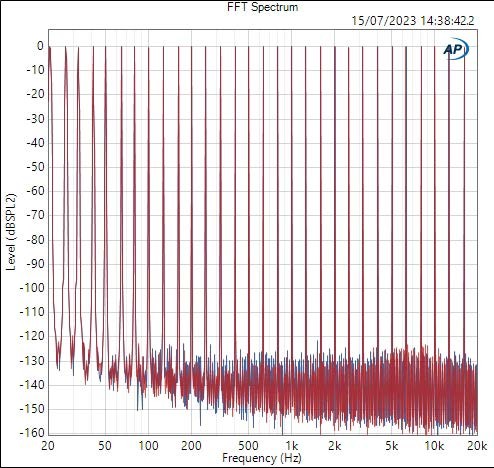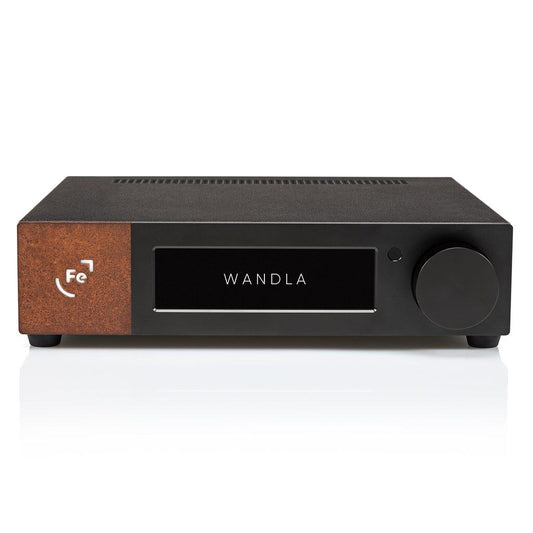BIG Performance in a Small Package - Ferrum WANDLA Review & Measurements
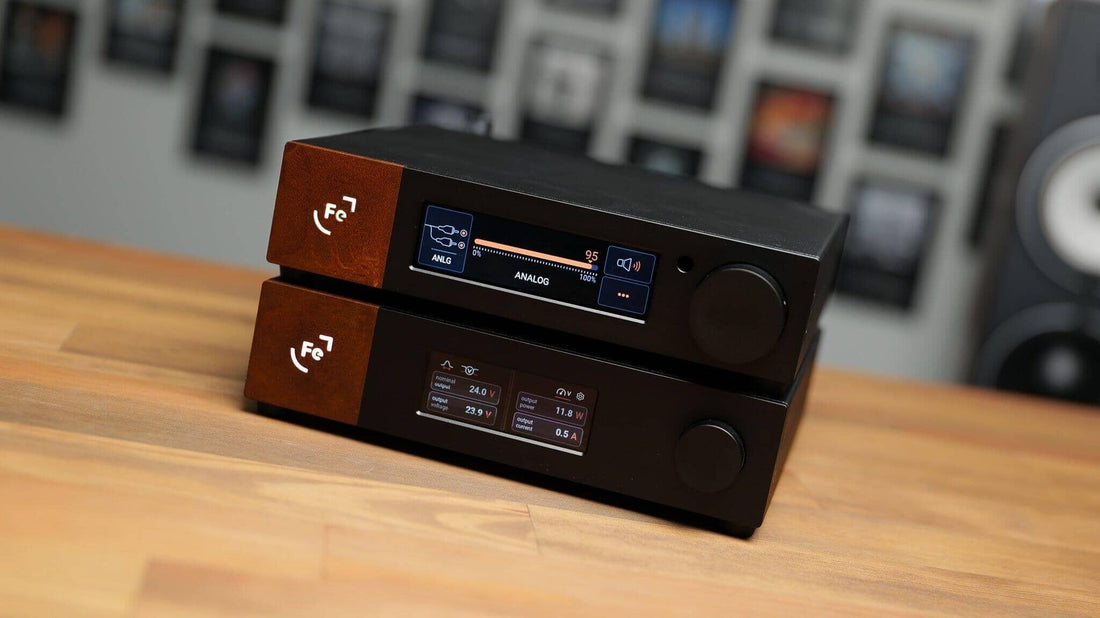
Introduction
The WANDLA is the latest offering from Ferrum, an ESS 9038-based DAC with some unique features that make it a standout choice over many competitors.
Design and I/O
The WANDLA retains the same form factor as Ferrum’s OOR, ERCO, and HYPSOS units, meaning users with multiple products in the lineup can make quite a neat-looking stack indeed. With how compact each of these units are, you shouldn’t have much trouble finding space for them on your desk.
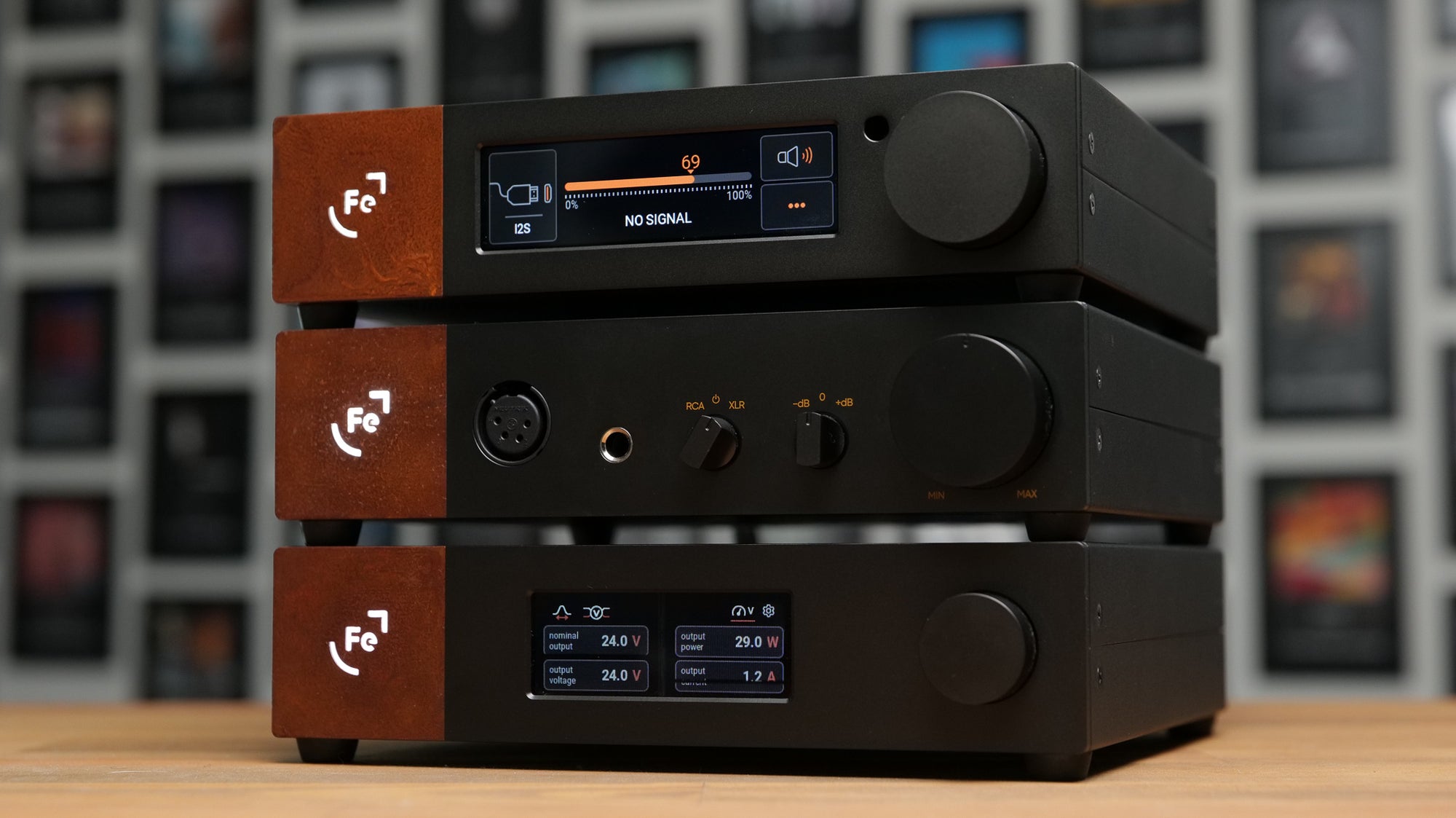
One concern held by owners of the OOR and HYPSOS was whether they would be able to power the WANDLA as well as their OOR from the single HYPSOS power supply, or if they’d need to make a choice between the two. Luckily Ferrum has also released a splitter unit which will allow the HYPSOS to power both an OOR and a WANDLA simultaneously.
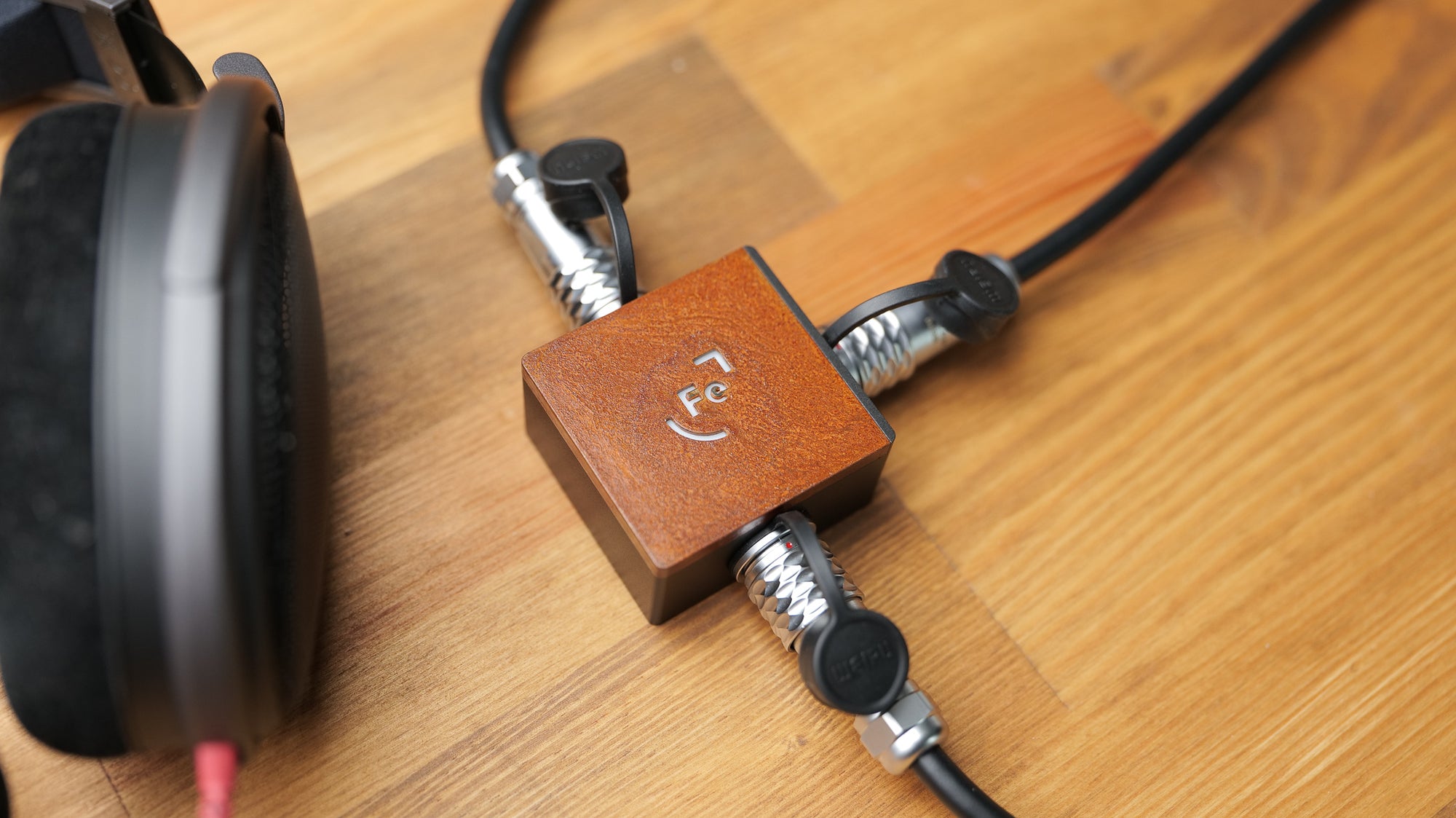
The chassis is the same matte black finish as the other Ferrum products, accented by the corten steel square and illuminated Ferrum logo, however the display is significantly larger than that of the HYPSOS and functions as a touch screen. This is to facilitate the wealth of features and configuration options the WANDLA has to offer. There is also a metal remote included so that you can control volume and other controls from the comfort of your listening position.
The WANDLA offers seven total input options: USB, optical SPDIF, coaxial SPDIF, AES, I2S, HDMI ARC, and also RCA analog inputs.

The analog RCA inputs do not go through an ADC, but are routed to the outputs in a fully-analog signal path with analog volume control, allowing the WANDLA to function not only as a DAC but also an analog preamp. This is certainly handy for those that may have a vinyl turntable, allowing them to have the WANDLA serve as the single central control unit for their entire system. It’s also worth noting that the single-ended signal fed to the analog input is immediately converted to balanced internally, and remains balanced the rest of the way through the device, helping to provide better performance at all stages later down the line such as volume control and the analog output stage.
Whilst there are no balanced analog inputs, the DAC itself is balanced and offers true balanced outputs. Many users will also be pleased to see the inclusion of a USB-C input rather than the typical USB-B, though I personally would have liked to see both connectors (as on devices from Hifiman and Soncoz), allowing users to more easily integrate the WANDLA to existing systems with their existing cables.
Internals
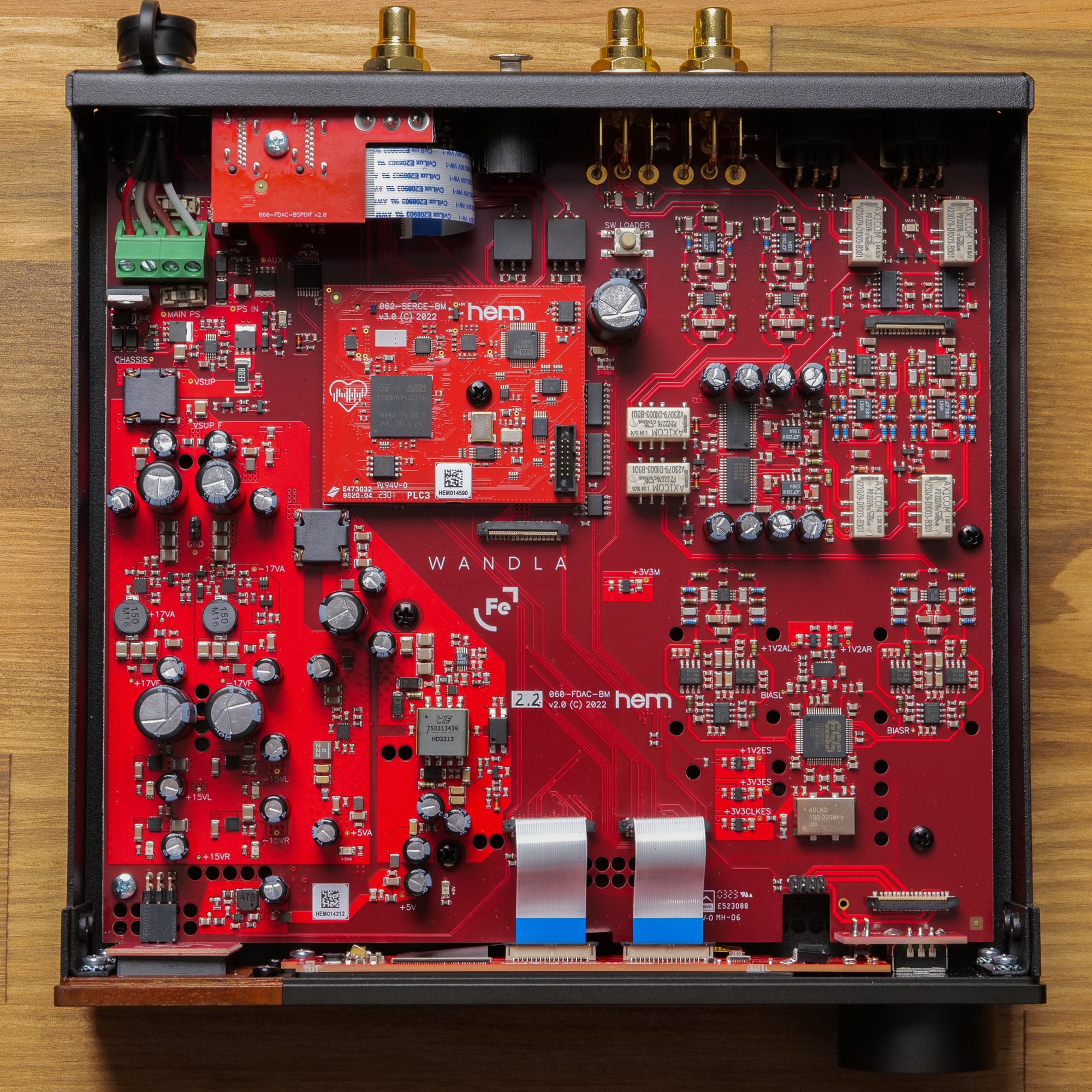
Taking a look at the internals of the WANDLA, there are a few interesting design aspects to note. The first is the daughterboard in the center of the device, called SERCE. This an all-in-one audio control board that will also be offered by HEM to other manufacturers as an OEM component. It acts as the brain of the device, handling all controls, outputting to the display, providing receiver functionality for all digital inputs including USB (no XMOS chip in sight!), and most interestingly to me, offers higher performance digital audio processing than a standard DAC chip.
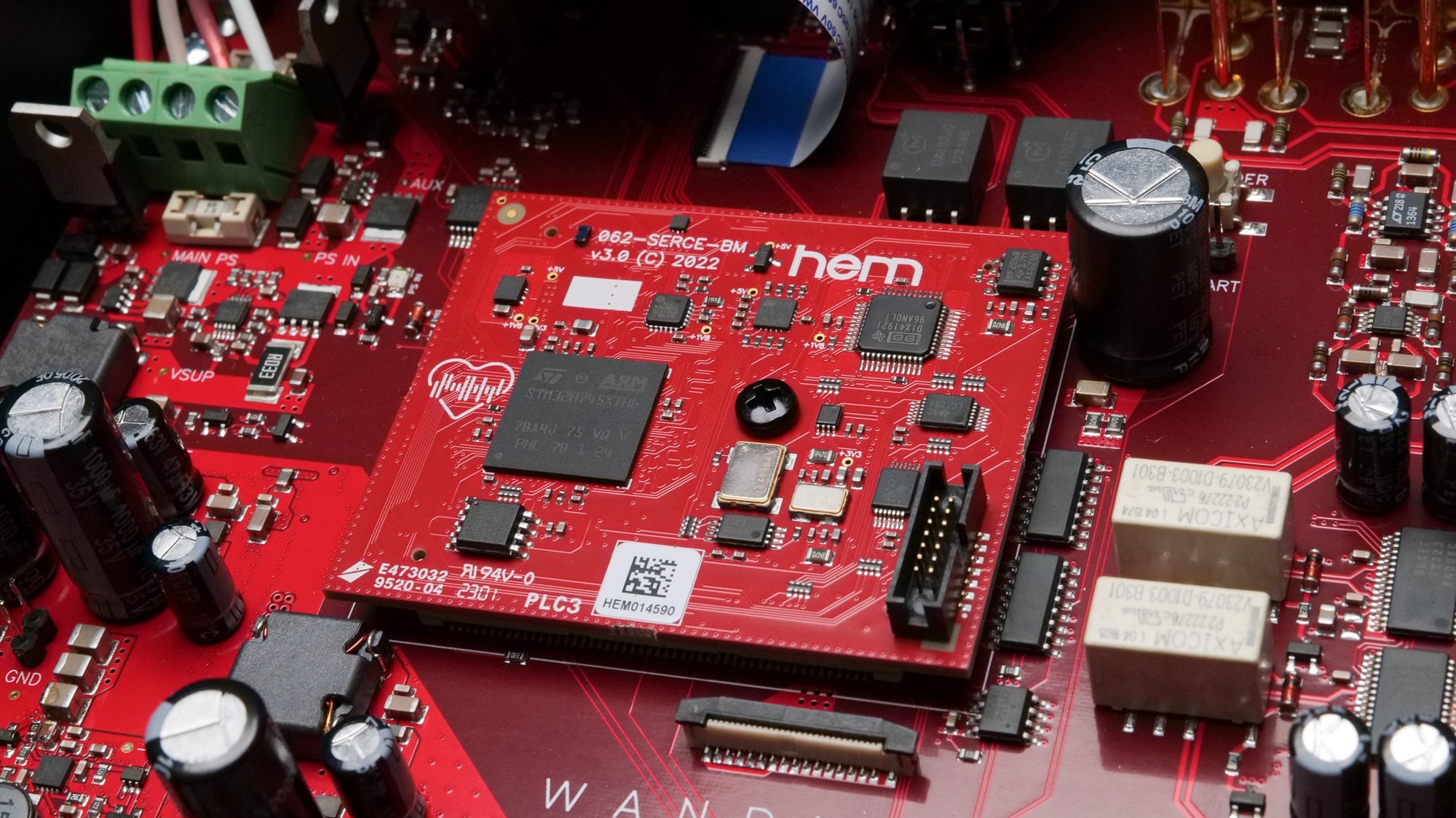
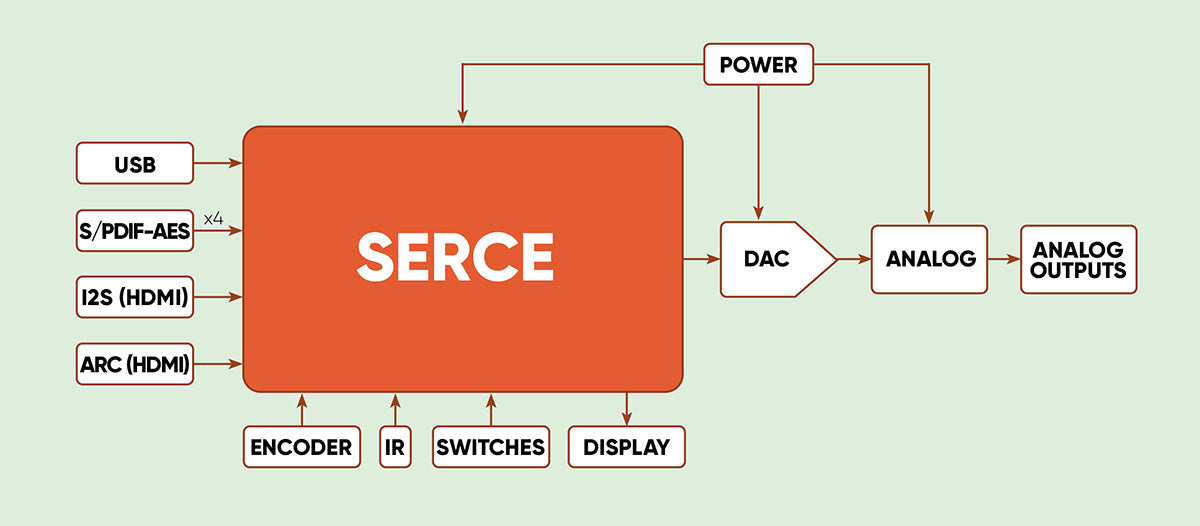
Taking advantage of this capability, Ferrum has partnered with Jussi Laako, the developer of the HQPlayer high-performance upsampling tool to design a set of high performance reconstruction filters and noise shapers for the WANDLA. Why is this important? Well, digital PCM audio is based upon ‘Nyquist Theorem’, which states that with 44.1khz audio, we can perfectly reconstruct the original waveform upto half the sampling frequency, 22.05khz, but only if you ‘band limit’, filter out any content above that frequency. Therefore an ideal filter design would attenuate everything above 22.05khz fully, but leave everything below 20khz untouched. The problem being that this takes computing power, and with the limited resources available, even modern flagship DAC chips from AKM and ESS have no filters which do this properly. Therefore with the computing power of SERCE available, these new ‘HQ’ filters are available to the user, and provide to my ear a significant subjective improvement over the stock ESS filters, as well as a measured improvement.
Then, the analog and digital sections of the device have independent power supply sections, isolated from each-other to minimize unwanted interaction.
For the DAC itself, the ESS9038 chip can be seen in the lower right, surrounded by power filtering and regulation components and the clock, with Ferrum’s IV stage design to the upper right and left. This IV (current to voltage conversion) stage is part of the ‘secret sauce’ of the WANDLA’s sound, and was something that I spoke to the Ferrum engineer behind the design about at Munich High-End this year. This device has been designed with both measurements and listening as validation, and I heard that they tried several other IV stage designs which had excellent measurements, but did not sound good enough to their ears. After various iterations and design revamps, they settled on the design seen here. They found it sound the best. Always nice to hear that listening tests have been an important part of the design of a product, and not just measurements alone!
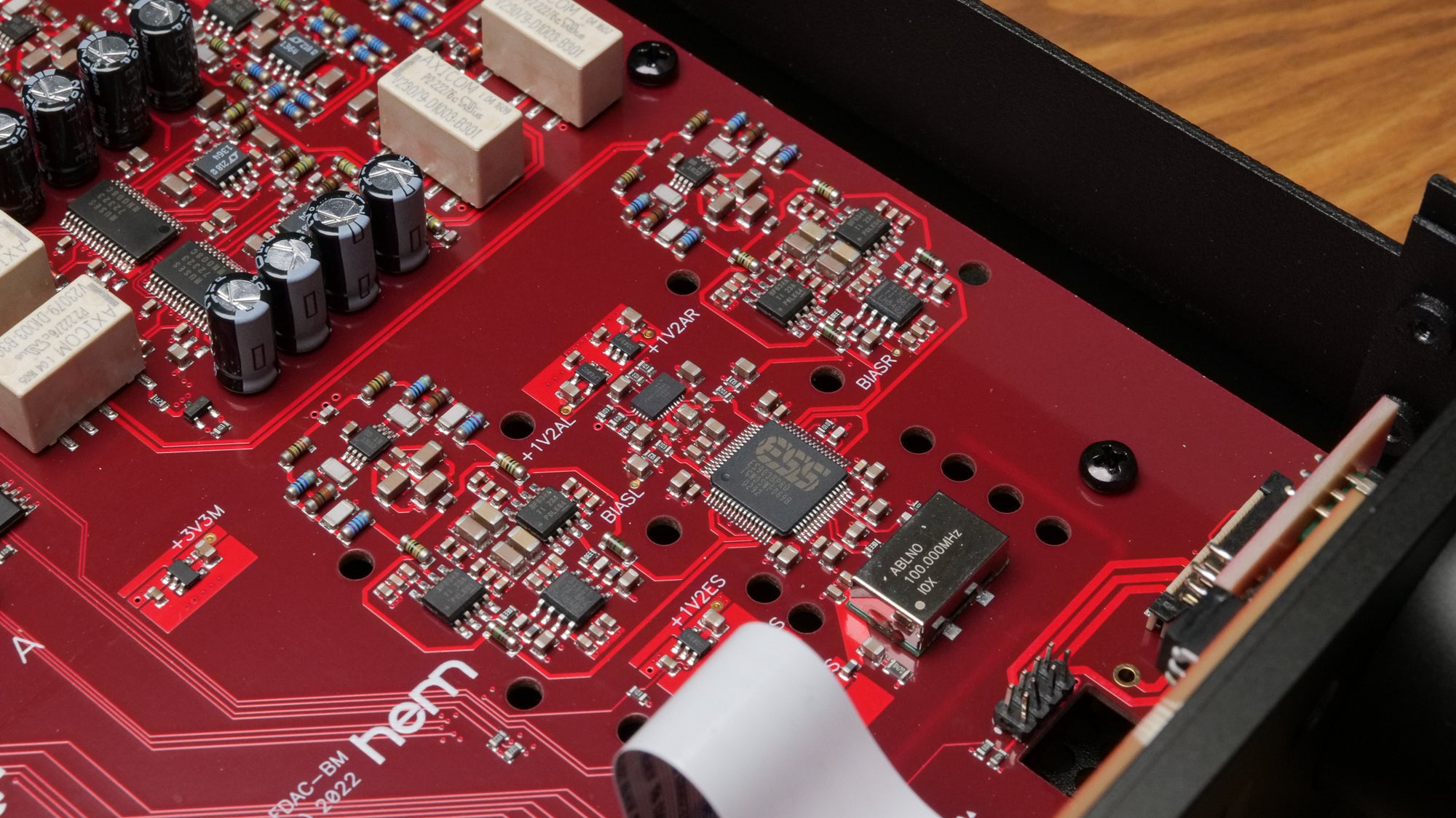
Above this, the output stage can be seen, in addition to two MUSES laser trimmed resistor attenuation ICs which facilitate the analog volume control.

The user has the choice of selecting digital volume control, in which case all attenuation is done in the digital domain by the SERCE processor, or in the analog domain, where the DAC converts the digital signal at full level, and then attenuation is done by the resistor ladder ICs. Having this as a choice is excellent to see, and no doubt users will be divided on which option is better. Some feel that less digital manipulation is always better, but some would argue that digital domain attenuation can allow for objectively more accurate results than analog. In any case, the choice is yours on the WANDLA. Perhaps we might even get the option for a ‘hybrid’ volume control in future similar to that of the RME ADI-2 or Rockna Wavelight?
Some may argue that for a device of this price tag, it would have been better to see dual ESS9038 chips instead of just one. However the primary reason to opt for two DAC chips is typically to reduce crosstalk, and as you’ll see in the measurements, the WANDLA has absolutely no issues in that department and outperforms many dual-chip products.
Software
Software is rarely something you think about on a DAC. Even very high-end units display the same sample rate information and perhaps some basic menus ( (if you get a display at all instead of just some indicator LEDs).
The WANDLA is different. All the features of the device are controlled with a fluid, responsive touchscreen UI that feels refined even down to the way the menu transitions from one area to another. As well as the usual offerings, selection of input, volume control, and power, there are some unique features not found elsewhere. The first of which (and perhaps my favorite) is the previously-mentioned ‘HQ’ filters developed in partnership with Jussi Laako. The user can also configure the 12V trigger port to act as an input or output, alter automatic wakeup and shutoff timings, automatic input selection, analog vs digital volume control, left/right balance adjustment, digital and analog gain/trim, as well as a host of options for changing the visuals of the device and I2S pinout settings. To say that this is a ‘customizable’ device would be an understatement. Doing it all in such an intuitive UI is excellent.
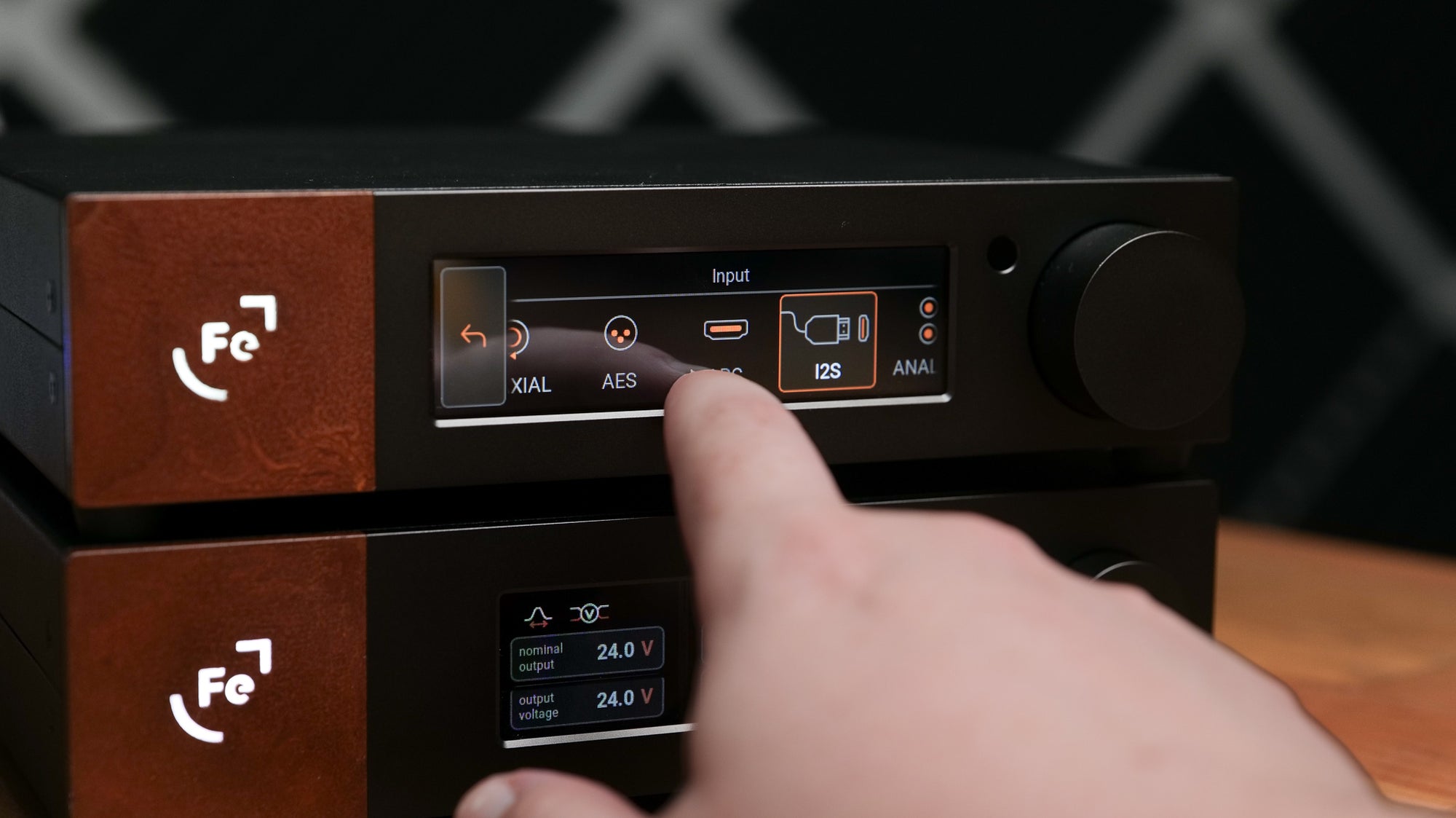
One undocumented feature I also noticed is that the sample rate/bit depth indicator shown on the display when playing to the DAC does not just show the bit depth of the data being fed to it, but instead shows the ‘true’ bit depth of what is being played. Meaning that if you play a 24 bit file that was dithered at 20 bit, the display will show 20 bit, not 24. I’ve even found a couple instances where the WANDLA exposed some 24 bit tracks as 16 bit in disguise!
Sound Quality
Fancy and extensive features are nice, but mean little if the product doesn’t sound as good as the competition. After all, we’re here for sound, and everything else is merely a cherry on top. Luckily, the WANDLA is an incredibly impressive DAC in terms of sound quality and it seems that the work done on various aspects such as the IV stage, custom filters, and power delivery have paid off.
I started by comparing the WANDLA to the Gustard X18, also an ESS9038 based DAC, but far cheaper at $749 vs the WANDLA’s $2800, and also one that by most measurements performs very well. However when it comes to the resulting sound, the WANDLA was a clear winner.

The most obvious difference was that the WANDLA lacked the slightly ‘clinical’ and cold presentation found in the X18 as well as many other ESS based DACs. It sounded closer to a true neutral to my ear and overall more realistic. Detail retrieval though was roughly on par. This particular aspect is something which I think many ESS DACs have reached a bit of a limit on, and rather than one DAC being more detailed than the other, it’s now more of a case of which DAC can better the other by offering that exceptional level of detail with the least compromise in other areas.
All too often, products present incredible detail but in an artificial and sterile-sounding manner, with others going too far the other way and sounding warm, ‘organic’, and rich but at the expense of resolution. The best products for me are the ones that are able to maximize detail, and retain a genuinely neutral, lifelike presentation.
Perhaps this advantage for the WANDLA is due in large part to the IV stage design. The X18 uses what seems to be a simpler IV stage design, and regardless of complexity, the difference in approach can be quite stark from product to product. Even its big brother the X26 pro uses quite a different approach for the IV stage to the WANDLA, and with Ferrum using measurements as a baseline, and then finalising and validating the design by ear, it perhaps isn’t a surprise that the end result sounds great, rather than just assuming it will sound great because it measures great.
The WANDLA is significantly more natural in presentation than any other ESS DAC I have heard without sacrificing anything in terms of sheer technical performance. And this is comparing like for like with the stock ESS linear phase filter. When you swap to the HQ filters, things improve even more.
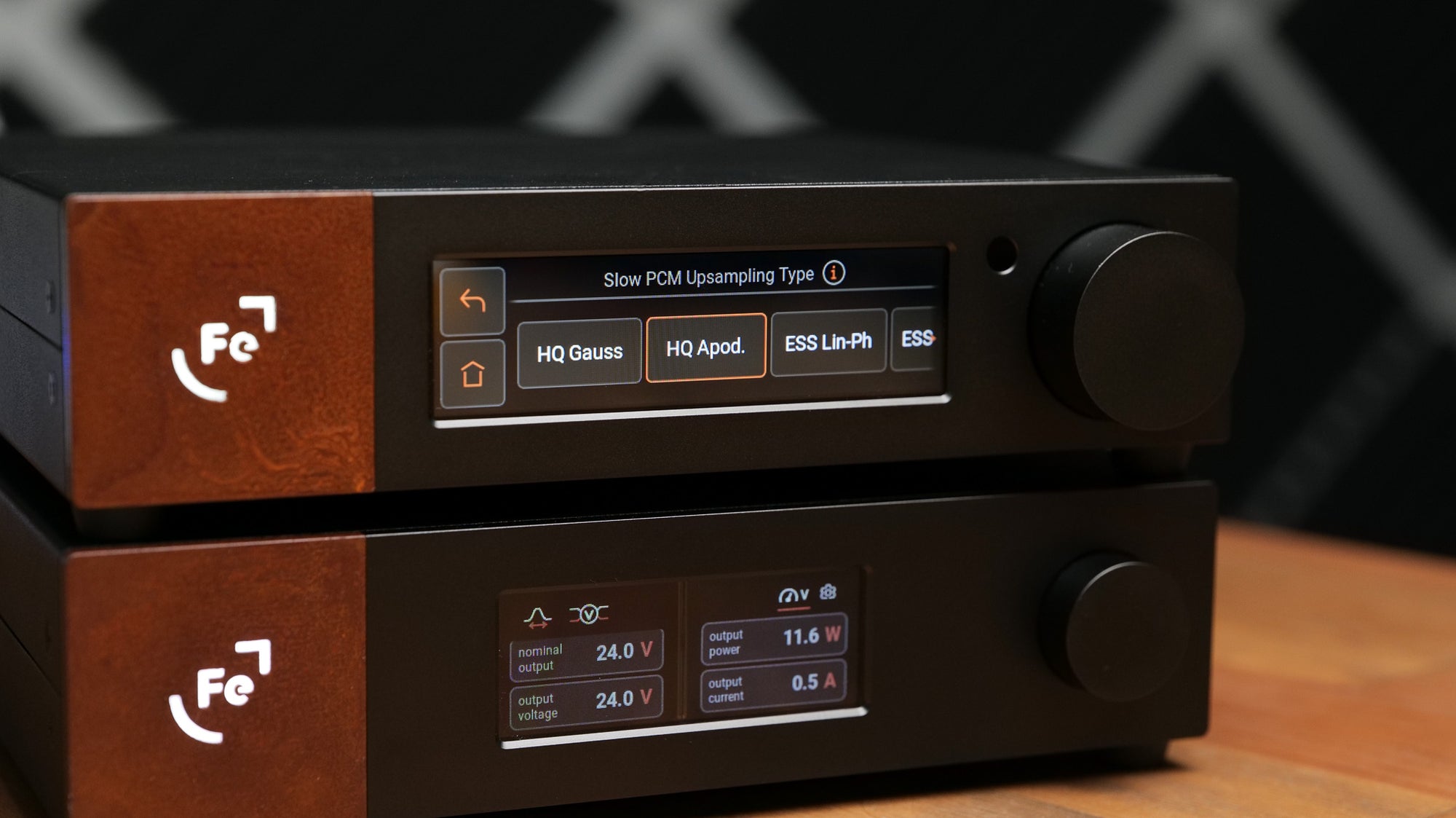
The HQ filters don’t provide any improvement in detail retrieval, nor to my ear any change in perceived tonality. Where they improve things is in soundstage and spatial presentation. Swap from ‘ESS Lin-Ph’ to ‘HQ Apod’ and immediately the soundstage expands, complex mixes sound more clearly separated and overall congestion is reduced. It introduces an effortlessness and ‘airy’ quality to the sound that for me provides a significant improvement in overall enjoyment and it really makes me wish more DACs would implement proper reconstruction filters.
When it comes to which of the two volume control settings was the better choice, I’d say that the difference here was minimal and both options provide an excellent result. At higher volumes, there was practically no difference whatsoever. The differences are slightly more obvious when operating at much lower volumes than I ever found necessary, whereby analog volume control begun to appear ever so slightly softer, but with no change in staging or separation. Digital volume control on the other hand retained the same level of incisiveness the whole way down, but at lower levels the output started to lose some ‘tangibility’ in terms of how elements in the mix were laid out in front of you.
With tracks like ‘Perimeter’ by Gidge, some elements would usually be directly between my speakers with others way off in the distance, and whilst using the digital volume control it seemed to bring these closer together. Overall, I slightly preferred analog volume control as spatial presentation is a big factor of immersion for me, but I usually kept the DAC in ‘bypass’ mode anyway and controlled the volume with my headphone amp or preamp.
The WANDLA is an incredibly impressive product, and was not out of place when compared to my personal favourite DAC, the $5600 Holo May KTE. The May wins out on timbre and clarity of separation, but the WANDLA did match the level of resolution, and even in soundstage, which R2R DACs are often known for, it happily traded blows with the May. I have not heard this level of performance from a DAC either at this price point, much less in this compact a form factor!
Lastly, you may be wondering whether the HYPSOS is a worthwhile upgrade for the WANDLA. I’d say most likely "no." There did seem to be a slight reduction in ‘glare’ or sharpness when using the HYPSOS instead of the stock power supply, but the difference was very subtle, and far less obvious than the change heard when upgrading the OOR from the stock power supply to the HYPSOS. This I suppose makes sense given as the OOR can benefit from the HYPSOS more due to the more dynamic power requirements.
If you already have a HYPSOS and OOR, it’s likely worth getting the splitter so you can power both devices from your HYPSOS. However if you are planning on getting a WANDLA solely as your DAC, the HYPSOS is a very subtle upgrade that I don’t think warrants the extra cost. You’d probably be better off putting the money towards an amplifier or headphone upgrade instead.
The WANDLA is without a doubt the best ESS DAC I have heard. In the future I hope to put it up against the Weiss DAC501/502 to see which of the two wins out, as that also is doing some proprietary digital processing rather than relying entirely on ESS’ own.
At $2800, the WANDLA is an excellent choice, subjectively. But as you’ll see in the next section, objectively as well in ‘usual’ areas such as SINAD and crosstalk, but in other areas such as reconstruction filter performance too.
Measurements
Measurements Include:
- THD+N (SINAD)
- THD+N vs Frequency
- Low Level Signal Output
- Reconstruction Filter/Upsampling
- Jitter
- THD vs Output Level (Power)
- Linearity
- Output Impedance
- Power On/Off Behaviour (Safety Test)
- Noise
- Intermodulation Distortion (IMD)
- Dynamic Intermodulation Distortion (DIM)
- Crosstalk
- Multitone
Additional measurements and test information available in the full report
Test Setup
- Audio Precision APx555 B-Series analyzer
- Measurement setup and device under test are running on regulated 230V power from a Furman SPR-16-Ei
- WANDLA was warmed up for 24 hours prior to testing
- WANDLA is in ‘bypass’ mode unless otherwise specified
- USB input, Balanced output used unless otherwise specified
- Tests shown are with a 100kΩ load unless otherwise specified
- Exact analyzer/filter configurations for each measurement are detailed in the full reports
- CH1 (Blue) = Left, CH2 (Red) = Right
Full Measurement Reports
Full Report (4V Analog Volume Control)
Full Report (4V Digital Volume Control)
Results
Dynamic Range (AES17): 120.2dB
SNR: 118.5dB
IMD SMPTE: -98dB
Noise Level RMS (20-20khz): 7.99uVrms
Noise Level RMS (20-90khz): 17.13uVrms
DC Offset: 29.73uV active, 77.55uV idle
Susceptible to intersample overs: Yes (only when digital volume is set to maximum)
Output Impedance: 44Ω Balanced, 22Ω Single-Ended
THD+N / SINAD
Disclaimer: SINAD should not be used as a figure to judge the overall performance of a product, it is a figure that combines several aspects of performance into one number whilst not including many others. It should be used as one factor among many when evaluating the overall objective performance of a device, and the type/structure of distortion can often be more important than the level of distortion/noise itself.
1khz Sine 10V (Bypass) Balanced Output:

Performance here beats the manufacturer’s claimed spec, always good to see manufacturers being honest or even slightly modest about their products performance.
1khz Sine, 4V Analog Volume Output:
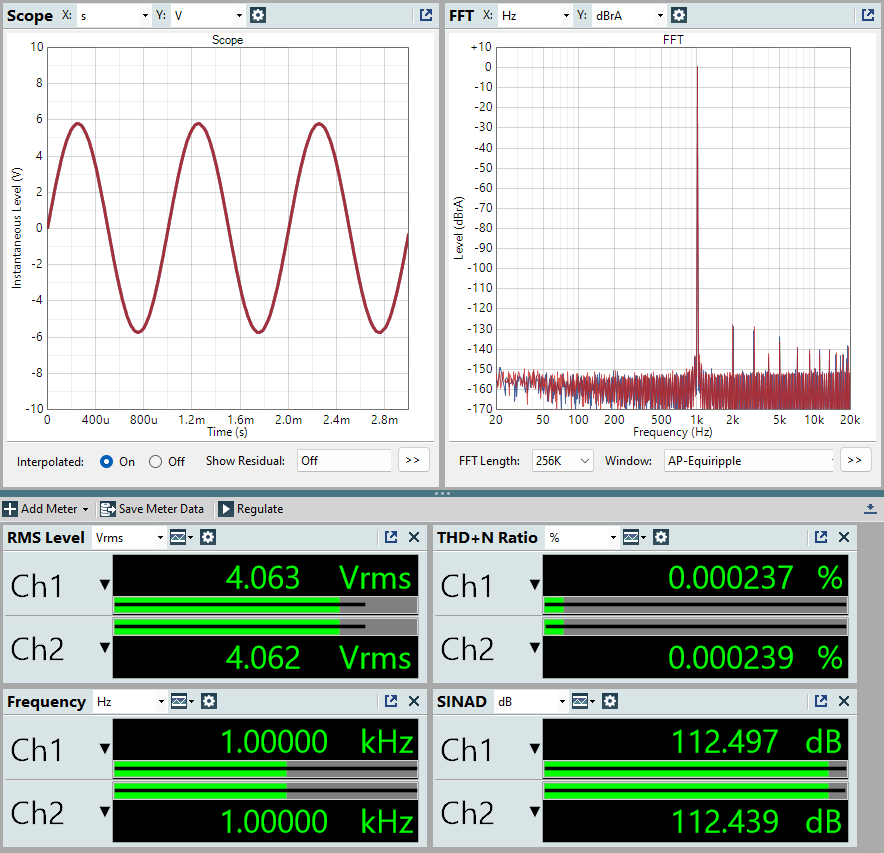
When using the analog volume option to reduce voltage to 4V line level (vol 92 on the WANDLA), performance is still excellent.
1khz Sine, 4V Digital Volume Output:
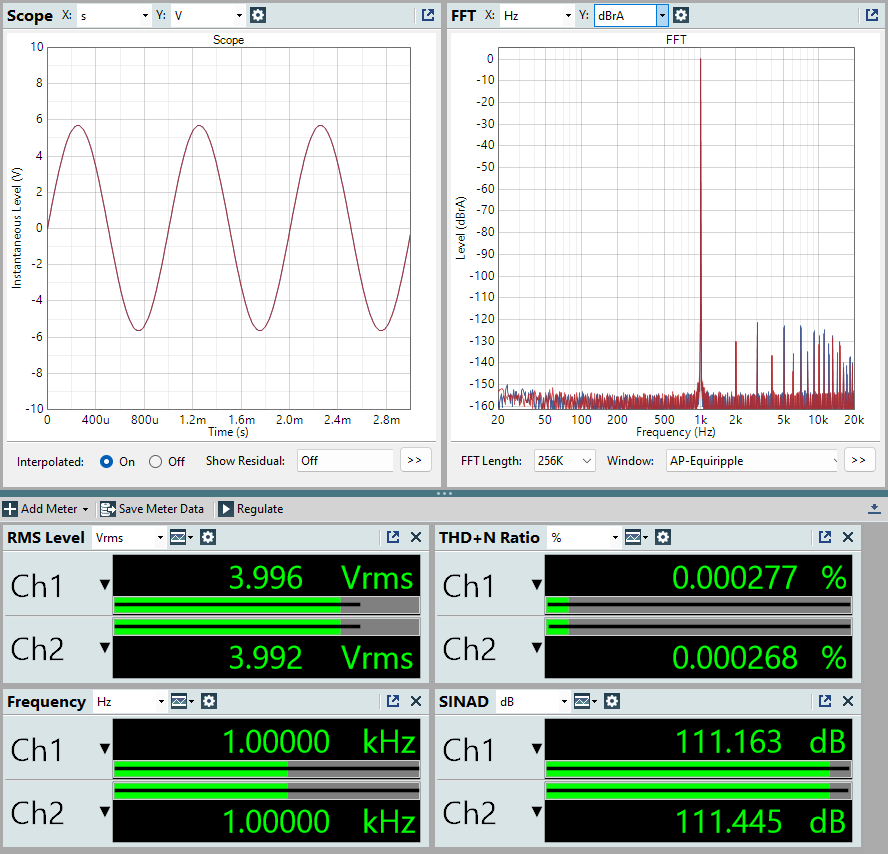
Interestingly the digital volume performs slightly worse than the analog when adjusting to 4V. Some distortion products are higher, possibly some impact from the chosen internal dithering option or truncation distortion. I have included full measurement reports of the WANDLA in bypass, analog volume, and digital volume modes if you are interested to compare the results of any test for each.
THD+N vs Frequency (96khz capture bandwidth)
(96khz bandwidth used on the analyzer. Don’t compare this directly to standalone audible band THD+N measurements as the measurement setup is not the same.)
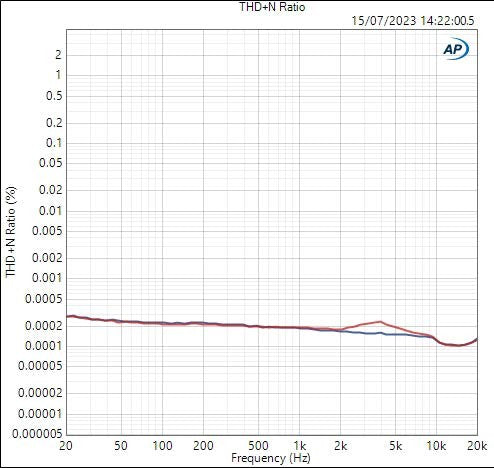
THD+N is mostly flat, and slightly lower at higher frequencies.
Low Level Signal Output
This test plays a very low level signal through the device to check for any unusual behaviour.

-90.31dBfs 24 bit dithered sine
Low signal levels are very clean. Slightly higher noise levels than some of the lowest noise DACs available, but only by a few dB.
Reconstruction Filter (Nyquist/Oversampling Filter)
This is one of the main selling points of the WANDLA. Most DACs do not have a reconstruction filter that truly adheres to Nyquist theory. Meaning they either do not fully attenuate by 22.05khz, or they roll off early, attenuating treble in the audible band. You can see that none of the ESS filters adhere to Nyquist theory, however both the ‘HQ Apod’ and ‘HQ Gauss’ filters do achieve a full 96dB (16 bit) attenuation by 22.05khz, and probably more given as we are actually limited by analog noise here in terms of how far down we can see.
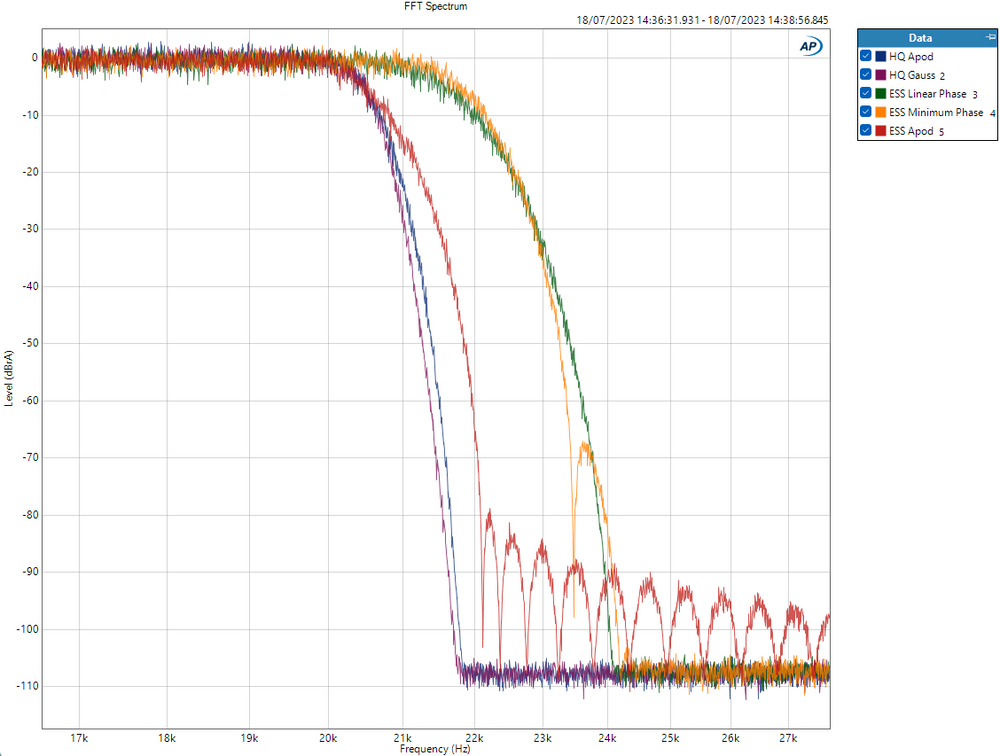
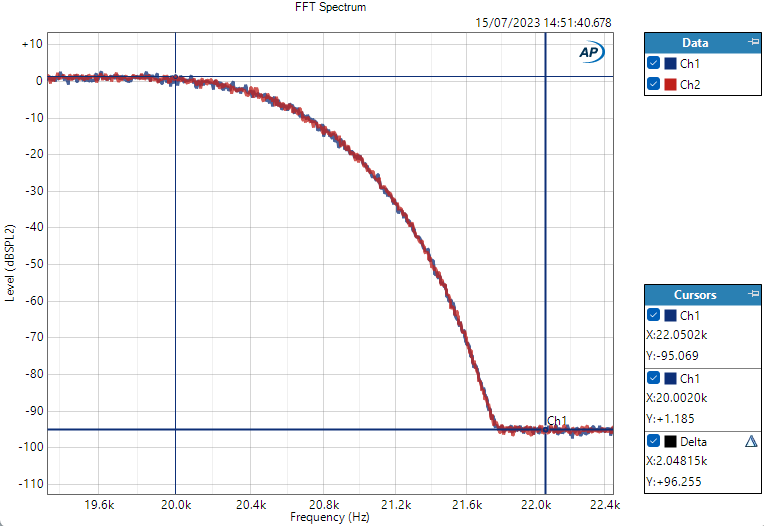
HQ Apod filter fully attenuates by 22.05khz, whilst not rolling off under 20khz
Jitter
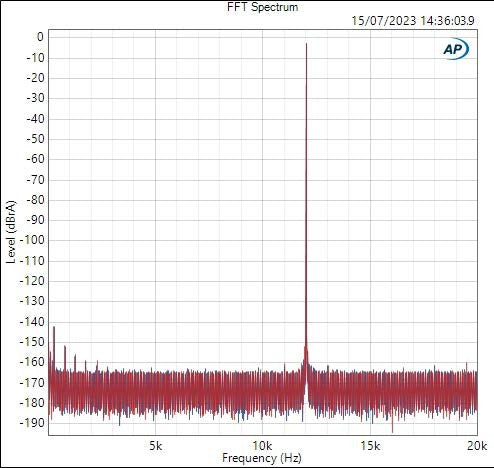
All jitter components are below -160dB
THD vs Output Level
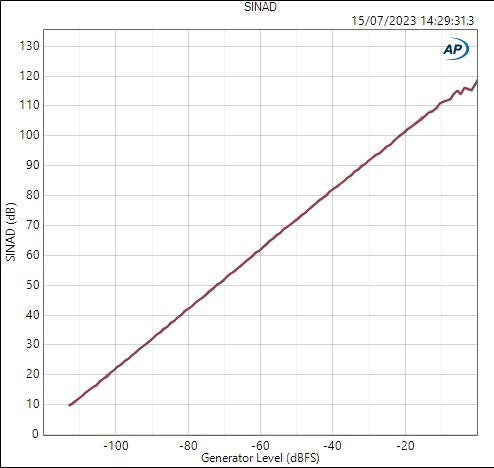
Distortion profile on the WANDLA remains constant and directly proportional to output level, with the exception of a slight change at the very highest output levels.
Linearity
This test plays a 1khz tone through the device, and steps down the level in small increments. Linearity measures how accurately the actual output of the device reflects the intended output. For example, if the level was stepped down by 20dB, but the output of the device was 19.7dB quieter, there is a 0.3dB nonlinearity, which would show as a 0.3dB rise on the graph.
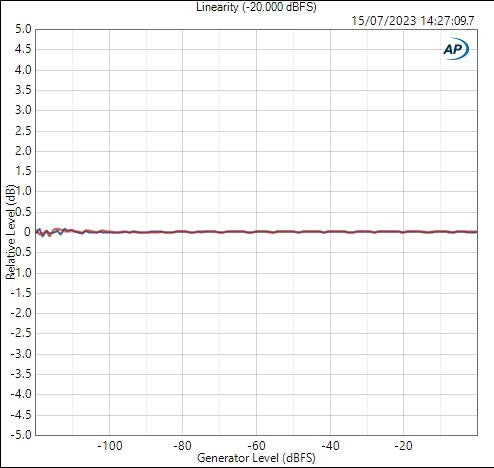
Bandpass filtered, this is measuring only the accuracy of the 1khz tone itself

No bandpass filter, this factors in noise into the result
Output Impedance
XLR (Balanced): 44 Ω
RCA (Single-Ended): 22 Ω
Volume Matching vs Attenuation
This test adjusts the amplifier to different levels using the volume knob, and shows the level difference in dB between the two channels.
Some amplifiers particularly at lower volumes will have channel imbalance. This test checks how closely the two channels of an amplifier match as volume is reduced.
The WANDLA uses either digital volume control, or analog volume control facilitated by a laser-trimmed resistor attenuation chip. Channel matching was within 0.05dB at all times on the analog volume control, and perfect with digital volume control.
Noise
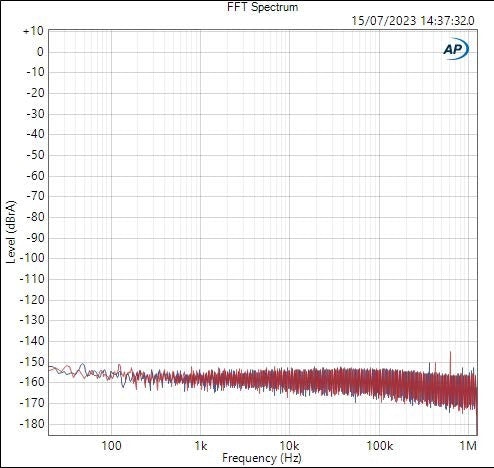
256k FFT, 3 Averages
No switching noise or other sources of noise observed upto 1Mhz.
IMD
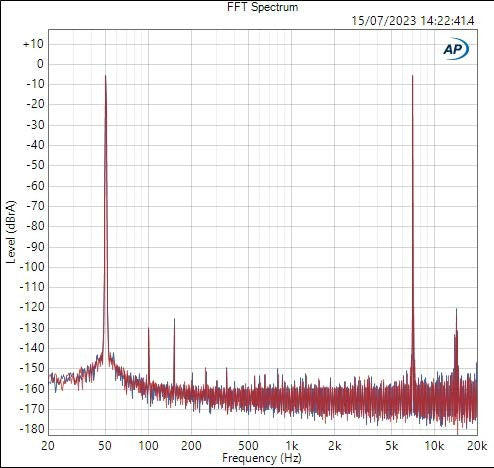
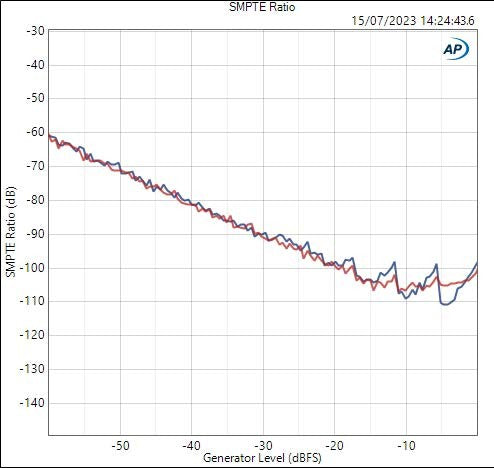
Crosstalk
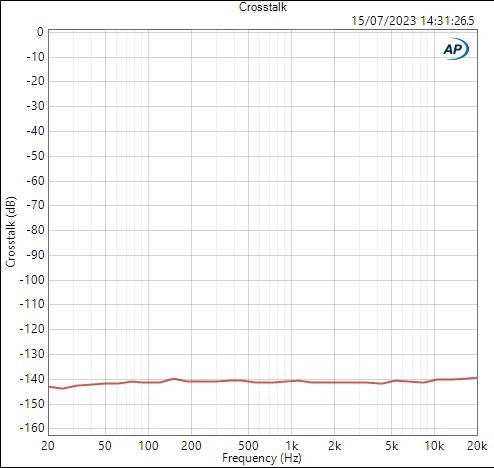
Crosstalk is exceptionally good, staying under -140dB at all times.
Multitone
